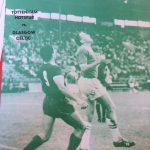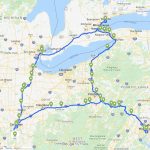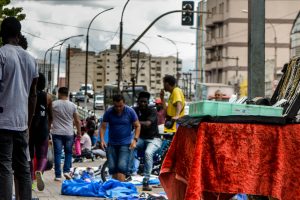The Holy-Land in Brazil:
Jewish Elements and the Relation between Pentecostalism and Politics
The Universal Church of the Kingdom of God (UCKG) is an important institution in contemporary Brazilian society and politics. The church owns the second largest TV channel in the country, broadcasting soap operas watched by a broad public. The sight of uniformed UCKG members and pastors handing out flyers and newspapers is a common scene in big cities…(READ MORE)
Sport and Play in the Settler Colony: Soccer and Christianity in Vancouver
 Nicholas Howe Bukowski: My project looks at the relationship between sports and Christianity in Greater Vancouver, British Columbia. Primarily, the project looks at soccer within one evangelical and one Pentecostal church that both play in the British Columbia Christian Soccer League. Through soccer and other forms of physical activity in these churches I am engaging with the formations of particular understandings of connection, relationality and binding in Pentecostal and evangelical Christianity. In particular I am interested in how people within these two evangelical and Pentecostal churches live in relation and in common with each other, other people in Greater Vancouver and people around the world. Leading to the questions: how might connection be formed through moving bodies? What political possibilities and formations within Pentecostal and evangelical Christianity are generated through sport? What does sport make possible in Pentecostal and evangelical Christianity? How has soccer-Christianity entanglement been part of the settler-colonial history of Vancouver? (READ MORE)
Nicholas Howe Bukowski: My project looks at the relationship between sports and Christianity in Greater Vancouver, British Columbia. Primarily, the project looks at soccer within one evangelical and one Pentecostal church that both play in the British Columbia Christian Soccer League. Through soccer and other forms of physical activity in these churches I am engaging with the formations of particular understandings of connection, relationality and binding in Pentecostal and evangelical Christianity. In particular I am interested in how people within these two evangelical and Pentecostal churches live in relation and in common with each other, other people in Greater Vancouver and people around the world. Leading to the questions: how might connection be formed through moving bodies? What political possibilities and formations within Pentecostal and evangelical Christianity are generated through sport? What does sport make possible in Pentecostal and evangelical Christianity? How has soccer-Christianity entanglement been part of the settler-colonial history of Vancouver? (READ MORE)
Convergences: Sport, Borders and Ethnicity in Scotland and Northern Ireland
 Shaughnessy Dow: Part of a larger research project about the means by which distinct groups inhabiting the same space conceive it in radically divergent ways, often constituted in opposition to each other, this project focuses more specifically on the means by which sport is imbued with meaning within the context of ethno-religious conflict, and in return, spectators are able to see their poltical views played out ritually on the sporting field, allowing another dimension to their self-identifications. Ultimately, the sporting pitch is argued to be the physical approximation of an unseen ontological borderland, the halfway line the midpoint. (READ MORE)
Shaughnessy Dow: Part of a larger research project about the means by which distinct groups inhabiting the same space conceive it in radically divergent ways, often constituted in opposition to each other, this project focuses more specifically on the means by which sport is imbued with meaning within the context of ethno-religious conflict, and in return, spectators are able to see their poltical views played out ritually on the sporting field, allowing another dimension to their self-identifications. Ultimately, the sporting pitch is argued to be the physical approximation of an unseen ontological borderland, the halfway line the midpoint. (READ MORE)
Photographing the Holy Land: A Visual Exploration of “Sovereignty”, “Sanctities” and “Soil” amongst Orthodox Jews in Jerusalem, Palestinian Israelis in the Galilee and Palestinian Christians in Bethlehem
 Hannah Mayne, Marianna Reis and Connie Gagliardi: This project presents a visual ethnographic exploration of “sovereignty”, “sanctities” and “soil” in the Holy Land amongst a diverse spectrum of the Israeli-Palestinian social and political landscape: Orthodox Jews in Jerusalem, Palestinian citizens of Israel in the Galilee and Palestinian Christians in Bethlehem. Informed by the Entangled Worlds Visual Ethnography Workshop, “Filming the Spirits”, led by Dr. Roger Canals Vilageliu of the University of Barcelona, this project seeks to ethnographically explore the Entangled Worlds of the Holy Land through the photographic image as a mode of writing, a method of ethnography and also an object of research. (READ MORE)
Hannah Mayne, Marianna Reis and Connie Gagliardi: This project presents a visual ethnographic exploration of “sovereignty”, “sanctities” and “soil” in the Holy Land amongst a diverse spectrum of the Israeli-Palestinian social and political landscape: Orthodox Jews in Jerusalem, Palestinian citizens of Israel in the Galilee and Palestinian Christians in Bethlehem. Informed by the Entangled Worlds Visual Ethnography Workshop, “Filming the Spirits”, led by Dr. Roger Canals Vilageliu of the University of Barcelona, this project seeks to ethnographically explore the Entangled Worlds of the Holy Land through the photographic image as a mode of writing, a method of ethnography and also an object of research. (READ MORE)
Conservative Christian Futures and Pasts: Exploring Infrastructures of Sovereignty and Display from Toronto to the US Capital

Christina E. Pasqua, Kyle Byron, Saliha Chattoo, and Suzanne van Geuns: For the “Entangled Worlds” project, a team of four graduate students from the University of Toronto’s Department for the Study of Religion conducted a one-week research road trip to Washington, D.C. Together, they drove from Toronto, ON to Cincinnati, OH before making their way to the capital. Along the way, they documented various sites of religious and national display seen briefly from the road or explored during intensive day trips through audio recordings, videos, photography, and tweets that have been curated into a Google map that retraces the route. They chose the U.S. capital as their destination for various reasons; Washington, D.C. is not only home to the infrastructures of the nation’s political memory and identity (e.g., Lincoln Memorial, the White House), but it is also a cultural hub with galleries and museums that reflect the sanctity of both political and religious institutions in the nation’s founding and future (e.g., the Smithsonian Institution, the Museum of the Bible). Today, as in the past, Washington houses many of the artefacts and institutions that establish rule: of God over the people, of the “United States” over the land, and of the people over the futures they envision. This understanding of God’s governance over the land and its people is not limited to D.C., however, nor does it go unchallenged. Moving across the land by car, crossing the border between Canada and the United States, this project approaches the capital as a web of meaningful connections that fan out across the North American continent and come together at this specific site through museum spaces. The map is therefore a productive means for reckoning with the competing voices that lay claim to highway infrastructures, farmland, city blocks, and even the air space through which the research team traveled. (READ MORE)
